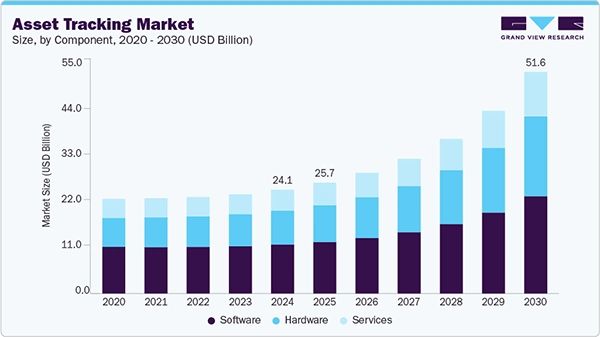Assets are the backbone of any industry. Without them, companies struggle to deliver value, achieve growth, and manage operations.
From medical equipment in the health care industry to heavy machinery on construction sites, assets are what keep industries on track. This is why tracking them is an essential part of being aware of what they have, where it is, and how it is being used.
And in today’s world, asset tracking is not just limited to one industry. It has become a popular practice in various industries to cut unnecessary costs and boost efficiency.
Let’s explore the top 13 industries that are hugely dependent on asset tracking to ensure their operations are on track.
Key Takeaways
- Asset tracking helps businesses track, monitor, and optimize their physical and digital resources.
- Industries such as healthcare and construction are the most benefited industries.
- Modern technologies for asset tracking include GPS, IoT, and RFID.
- Major benefits include improved efficiency, theft protection, and lower costs.
The very first industry is healthcare. From operational medical equipment to ventilators and wheelchairs, every equipment needs to be tracked for its quick availability during a medical emergency. Improper Asset tracking in such an environment can even result in someone’s death. Proper tracking ensures that there is no shortage or stockout.
Hence, for proper utilization, inventory management, and operations efficiency, asset tracking is very crucial in healthcare.
In manufacturing industries, machines, tools, and raw materials play an important role. Tracking them helps to run smooth operations. Real-time data of raw materials and other products minimizes delays, and by analyzing consumption and demand through tracking, high-quality products can be maintained. Theft prevention is also one of the benefits of asset tracking in the manufacturing industry.
The core concept of transportation and logistics is customer satisfaction through timely delivery. And this can be made better by the use of tracking devices to get a real-time update of the vehicle’s location and the status of the cargo.
Consistent monitoring of the goods ensures cargo safety and security. Also, help to check if the working hours for the driver are completed. Integration of asset tracking with logistics and transportation results in more reliable, safe transportation and efficient operations.
In the construction industry, asset tracking helps to locate heavy machinery, vehicles, and tools, and find small equipment that is usually scattered during construction. This way it maximizes the machinery use, reduces theft cases, and helps schedule timely maintenance. Asset tracking can make management better and cut unnecessary costs.
The main purpose of asset tracking in retail is Inventory management. This helps to reduce the chances of overstock or stockouts. On-time product availability to the customer, as needed, satisfies the customer.
Efficient tracking of assets ensures a smooth shopping experience for customers as well as easy retailing.
Interesting Fact
According to a report by Zebra Technology, companies that use asset tracking can improve their inventory accuracy by up to 30%.
In the education industry, asset tracking helps to maintain laboratory accessories, computers, and sports gear. It also helps through equipment maintenance, reducing misplacement cases, and encouraging the sharing of resources, such as computer labs.
Tracking valuable assets in the agriculture industry, such as machinery, livestock, and production or crop yield, can help you analyze production and consumption for better growth. Such a management ensures the proper utilization of framing equipment and land.
Hydro Pipelines and safety equipment are the essential parts of the oil and gas sector. Tracking, which boosts the safety, minimizes the downtime, and assures the required compliances, as well as rigorous regulations are satisfied. This also provides 24-hour visibility and gains a competitive advantage.

The telecommunications industry has to operate with a lot of tools, connectivity vehicles, and other devices used for installation and maintenance. Asset tracking helps to organize them in a required way and improve technician productivity, resulting in quick services and efficient work.
Public safety departments such as police, firefighters, and other emergency services are very dependent on the vehicles and protective gear. Asset tracking makes sure that all the required amenities are ready to use, maintained, and available on time.
Hospitality uses a vast range of equipment and amenities, such as kitchen equipment and guest amenities. And all these can be tracked in an efficient way to reduce theft cases, ensure housekeeping and kitchen are on track, and elevate guest travel experience.
Energy businesses require a maintained infrastructure, including service vehicles and power plants. Asset tracking can help monitor infrastructure, manage service vehicles, and schedule maintenance, avoiding service disruptions.
The aerospace and defence industry has to deal with very expensive and high-value assets, including aircraft parts, weapons, and other high-maintenance tools. Asset tracking ensures adherence to strict rules and compliance that reduce expensive losses and repairs, and improve readiness.
In this competitive and advanced world, industries are not adapting asset tracking as a luxury but as a necessity. From healthcare to aerospace and defence, industries are heavily dependent on asset tracking to work more efficiently and to stay competitive. And in the upcoming years, asset tracking will continue to grow and will make industries safer and efficient.
Asset tracking is the process of monitoring tools and equipment that are either physically or digitally available. This uses tools like barcode, RFID, GPS, or IoT sensors.
It helps different industries by reducing their losses, improving their efficiency, and optimizing resource usage.
Industries with a variety of equipment in use, such as healthcare, manufacturing, construction, and many more, are getting the most benefit from asset tracking.
It depends on the business requirements, but they can still start with simple barcodes and advance with their business growth.
